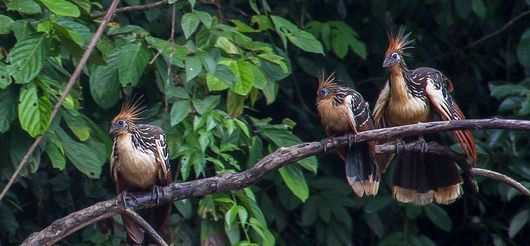Co-developing a community camera trapping programme to deliver benefits of living with wildlife
04 March 2022
04 March 2022
The Rungwa-Ruaha landscape in United Republic of Tanzania at nearly 50 000 km2 is one of the most important wildlife areas in Africa and it supports one of the world’s largest remaining populations of lions Panthera leo and globally significant populations of African wild dogs Lycaon pictus, cheetahs Acinonyx jubatus,...
The presence of forested islands creates edge habitats for many wildlife species, such as jaguar Panthera onca, tapir Tapirus terrestris, capybara Hydrochaeris hydrochaeris, harpy eagle Harpia harpyja, to name a few. The human population density in the region is very low (0.4 people/km2), with communities consisting of predominantly indigenous Makushi...
Sanjay Gandhi National Park (SGNP) is one of four parks in the world adjacent to a large metropolis, that occupies about 100 km2 with a minimum density of ~20 000 people/km2 and contains diverse wildlife such as chital Axis axis, sambhar Rusa unicolor, mugger crocodiles Crocodylus palustris, macaques Macaca mulatta...
This study examines protected area management in the Congo Basis, an area comprising 3.7 km2 and 34 protected areas across five countries (Cameroon, Central African Republic, Democratic Republic of Congo, Gabon, and Republic of Congo) to assess what impacts – both positive and negative – these areas are having on...
Applying adaptive management in resource use in South African National Parks: A case study approach
18 December 2019
18 December 2019
This study examines the effectiveness of the SANParks management strategy for ensuring sustainable use and providing resource users with socio-economic benefits. It does so by examining three case studies on plant use in national parks with regard to the development of criteria and indicators for monitoring resource use, and the...
Shared governance of protected areas in Africa: case studies, lessons learnt and conditions of success
18 December 2019
18 December 2019
This study focuses on shared governance of protected areas (PAs) in sub‐Saharan Africa and aims to highlight good governance practices for PAs in the region. Based on 10 case studies of shared governance of PAs from across five countries in Africa, as well as on information from the literature, the...
African Solutions in a Rapidly Changing World: Nature-based solutions to climate change by African innovators in Protected Areas
18 December 2019
18 December 2019
This publications includes a selection of solutions offered by African marine and terrestrial protected areas to reduce climate vulnerability and increase natural and community resilience. It demonstrates that effective nature-based solutions to climate change can be implemented through local and regional actions that bring benefits to both biodiversity conservation and...
Exploring Prospects for Enhancing Community Participation in Protected Area Management: A case study of the Moremi Game Reserve Area
18 December 2019
18 December 2019
Dominant approaches to wildlife utilization in protected areas exclude local community participation. This results in conflict between protected areas and adjacent communities. This study aimed at examining factors affecting community participation in wildlife resource use and management in the Moremi Game Reserve in the Ngamiland area of Botswana. It is...
Changing governance, changing inequalities: Protected area co-management and access to forest ecosystem services: a Madagascar case study
18 December 2019
18 December 2019
Frequently, local communities are involved as a partnering co-management in order to increase their representation, empower marginalized groups, increase trust, and promote social learning. This study adds to the evidence base in this area by examining which forest ecosystem services (ES) are considered most important by local communities in Madagascar,...
The Congo’s Nouabalé-Ndoki National Park: How Indigenous Lands Became an Emblem of Rooseveltian “Wilderness Conservation” in Africa
18 December 2019
18 December 2019
The Nouabalé-Ndoki National Park (NNNP), in the north of the Republic of the Congo (Congo), is one of the most renowned protected areas in Africa. The park has come under scrutiny, however, for its impacts on, and relationship with, the area’s original inhabitants, particularly the Ba’aka Pygmies. This article provides...

